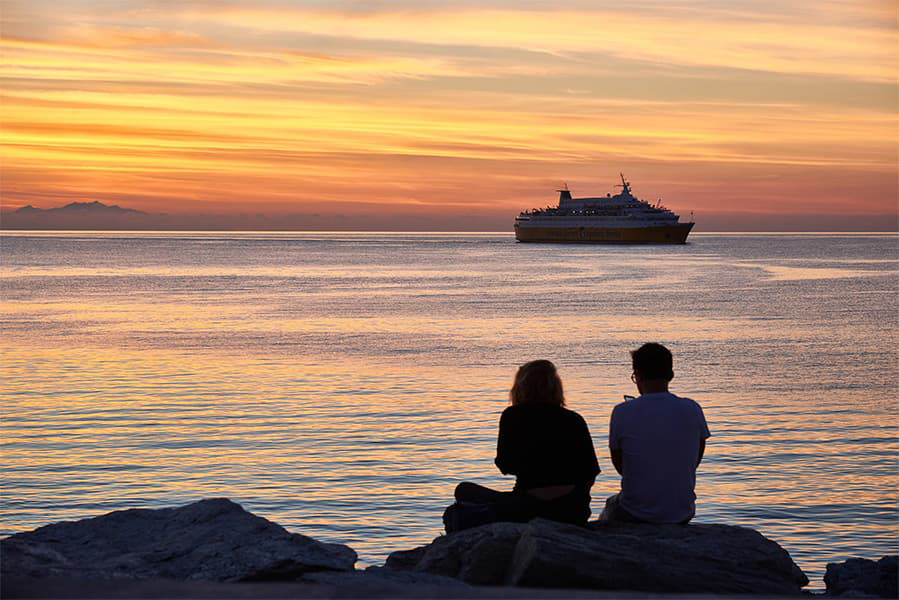Karlskrona - Gdynia
Ferries to Poland
Karlskrona - Gdynia
Ferries to Poland

Depending on the season their are usually 2 daily and 16 weekly sailings between Karlskrona and Gdynia. Stena Line provides the ferry from Karlskrona to Gdynia. Karlskrona Gdynia ferries cost between $221 and $1147, depending on ticket details. Prices exclude any service fees. Ferry timetables change seasonally, use our Deal Finder to get tickets, pricing, schedules and availability.
The earliest Karlskrona Gdynia ferry typically departs Karlskrona at about 08:00 and the last ferry usually leaves at 23:59.
Ferries from Karlskrona to Gdynia sail in around 10 hours 30 minutes. The fastest ferry is approximately 9 hours. Ferry duration can vary by ferry provider and can be impacted by weather conditions.
There is 16 weekly sailings from Karlskrona to Gdynia provided by Stena Line. Timetables can change from season to season.
The price of a ferry from Karlskrona to Gdynia typically range between $221* and $1147*. On average the Karlskrona Gdynia ferry is $571*. The cheapest Karlskrona Gdynia ferry prices start from $221*. The average price for a foot passenger is $444*. The average price for a car is $645*.
Pricing will vary depending on number of passengers, vehicle type, route and sailing times. Pricing is taken from searches over last 30 days and exclusive of service fees, last updated December 25.
The distance between Karlskrona to Gdynia is approximately 228 miles (368km) or 198 nautical miles.
Yes, Karlskrona Gdynia ferries allow cars onboard with Stena Line between Karlskrona and Gdynia. To view car ferry tickets and prices between Karlskrona and Gdynia use our Deal Finder.
Stena Line allow foot passengers on Karlskrona Gdynia ferries.
Stena Line allow pets on ferries from Karlskrona to Gdynia. Please also note that your pet may have to stay in the vehicle during the journey.
More routes than anyone else.

Compare fares, times & routes in one place.
Change plans easily with flexi tickets.

Book e-tickets & manage trips in-app.
Live ship tracking & real-time updates.

Top-rated customer support when you need it.
| Karlskrona - Gdynia Ferry Route Summary | ||
|---|---|---|
| Departure Country | Sweden | |
| Destination Country | Poland | |
| No. of Operators | 1 | |
| Operators | Stena Line | |
| Average Price | $571 | |
| Average Daily Sailings | 2 | |
| Average Weekly Sailings | 16 | |
| Average Sailing Duration | 10 h 30 m | |
| Fastest Sailing Duration | 9 h | |
| First Ferry | 08:00 | |
| Last Ferry | 23:59 | |
| Distance | 198 Nautical Miles | |
* Prices subject to change, pricing is taken from last 30 days, last updated 1 December 2025.
The Swedish city of Karlskrona is home to Sweden's only remaining naval base and is the headquarters of Sweden's Coast Guard. Referred to as Sweden's only baroque city, Karlskrona is spread over 30 islands and lies on the eastern part of the Blekinge Archipelago. Once the property of the Swedish Nave, the islet of Stumholmen is now home to the National Naval Museum (Marinmuseum).
An important day for the residents of the city is the day before midsummer's eve, when the town puts on a large fair that usually attracts many tens of thousands of visitors. The fair, called Lovmarknaden (The Leaf Fair), is also popular with the city's residents. Also held in late June/early August, in the town's harbour, is a festival called The Sail where sailing boats line up at the pier and where many families go to have something to eat and drink. Another attraction in the city is its town square which is the largest main square in Scandinavia.
Karlskrona Ferry Port has a range of services and facilities for travellers. The port provides short and long stay car parks with conveniently located spaces for disabled drivers.
The Polish city of Gdynia is one of the youngest Polish cities and lies on the Baltic Sea coast. The city has a thriving and busy harbour and centre and is a popular place to visit, especially during the summer months, because of its lovely sandy beaches. The city's port is one of Poland's major seaports and is a major centre of shipbuilding and is also a major centre of business all of which has made it Poland's most prosperous city.
Gdynia is located close to the Polish cities of Gdansk and Sopot which together form the Tricity conurbation which helps to develop economic activity for the region. If you are especially interested in 1920's and 1930's architecture, the Gdynia may be the perfect destination for you as there is not much in the city that is older than this. Popular attractions in the city include two ship museums, the frigate Dar Pomorza and the destroyer Blyskawica. Also of interest is the Oceanographic Museum and Aquarium that enables visitors to further develop their understanding of the sea.